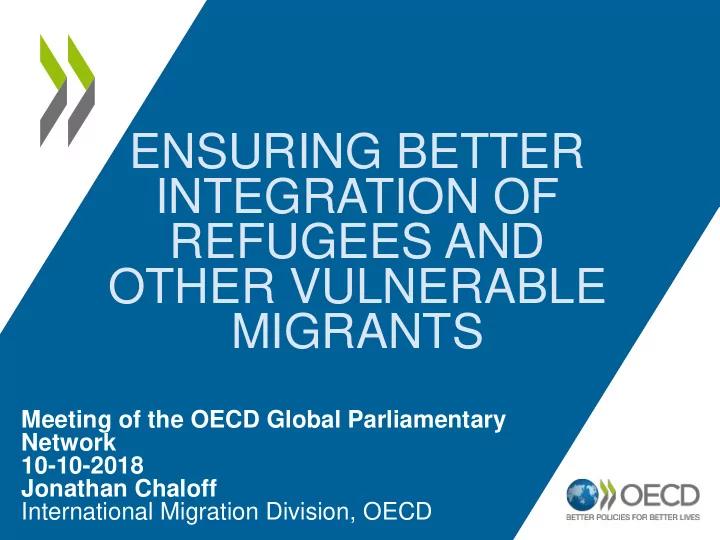

ENSURING BETTER INTEGRATION OF REFUGEES AND OTHER VULNERABLE MIGRANTS Meeting of the OECD Global Parliamentary Network 10-10-2018 Jonathan Chaloff International Migration Division, OECD
Context: declining flows in most OECD countries means that the priority is now integration Evolution of the number of new asylum seekers in OECD countries and the EU, 1980-2017 Source: UNHCR, Eurostat, OECD calculations. Much larger inflows in countries neighbouring Syria (>3m Syrian refugees in Turkey, 1m in Lebanon, 650k in Jordan) The Asia and Pacific region is home to close to 8 million people of concern to UNHCR, including 3.5 million refugees.
Labour market integration of refugees took a long time in the past Employment rate by immigrant categories and duration of stay European OECD countries, 2014 Source : EU-OECD (2016), How are refugees faring on the labour m arket in Europe? A first evaluation based on the 2014 EU labour force survey ad hoc m odule , DG EMPL Working Paper 1/ 2016.
Lessons learned Improve co- Rapid Address Adapt education, ordination of initial transition to specific factors health systems, and long-term housing employment of vulnerability response • Establish a • Provide • Better co- • Tailor for: crisis services as ordination • Unaccompani response plan soon as between ed minors in advance possible health-care • low-educated providers, • Identify • Facilitate refugees improve actors labour market • Refugee triage access for • Keep capacity mothers with asylum • Factor during “scale- young seekers with employment down” children high and prospects of educational being allowed opportunities to stay into dispersal policies
Managing integration: Whole of Society Approach Involve different levels of government • National, sub-national, local level of government. Reception and dispersal requires co-ordination am ong levels of governm ent. Involving different actors • Employers, civil society, social partners, etc. Collaboration in a clear fram ew ork is at least as im portant for sustainability than funding Across different countries • Co-operate with countries of origin and first asylum. Managing m ovem ents, sharing inform ation, sustaining integration.
http://www.unhcr.org/5adde9904
Managing the flow of humanitarian migrants Improve channels for complementary pathways for people seeking protection First Permits granted by OECD countries (29) to Syrians, Eritreans, Iraqis, Afghans and Somalis by permit type, 2010 and 2016 Family permits (left axis) Labour permits (right axis) Student permits (right axis) 120 000 12 000 100 000 10 000 80 000 8 000 60 000 6 000 40 000 4 000 20 000 2 000 0 0 2010 2011 2012 2013 2014 2015 2016
8/11 For further information www.oecd.org/migration
Recommend
More recommend